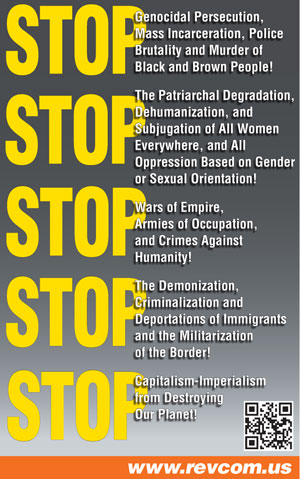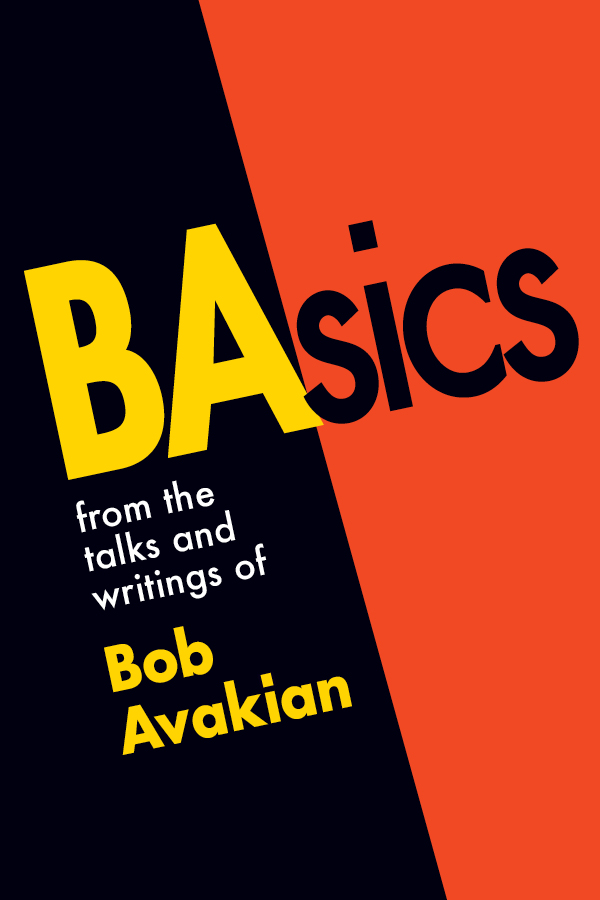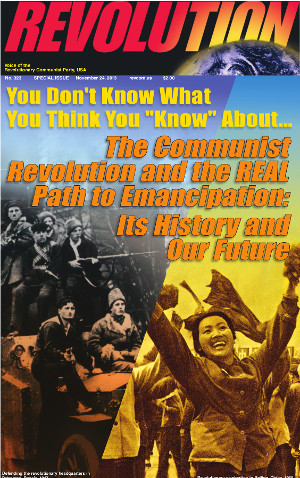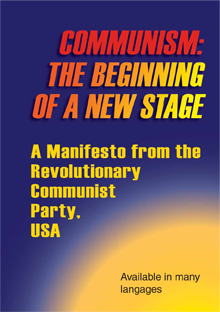April 1965—The U.S. Invasion of the Dominican Republic and the Heroism of the Dominican People
April 27, 2015 | Revolution Newspaper | revcom.us
This Tuesday, April 28, marks the 50th anniversary of an extremely important struggle. On that day in 1965, a complex chain of events culminated in an armed uprising in the small Caribbean nation of the Dominican Republic (“the DR”). The uprising’s immediate target was a U.S.-backed dictatorship, but in a larger sense it was part of a rising tide of different forces at that time challenging U.S. imperial power around the world, even right in what the U.S. likes to call its “backyard.” Because of this, the U.S. government wasted no time dispatching overwhelming military force to try and snuff out the rebellion.
In spite of the huge disproportion in power between the U.S.—then, like now, the most powerful country in the world—and the thousands of hastily armed and organized rebels in the DR, it ended up taking the U.S. days just to retake the capital city of Santo Domingo, and several months to fully defeat the insurgency. And more important, the U.S. invasion further exposed the brutal imperialist nature of the U.S. to people around the world and at home, and thus helped fuel the flames of revolution that raged across the world, including in the U.S. itself, for much of the next decade.
Background: Rafael Trujillo and the 30-year Reign of U.S.-sponsored Terror
1965 was not the first U.S. invasion of the DR—in fact, it was the fourth. In 1916 the U.S. not only invaded but occupied the country for eight years. During that time the U.S. created the National Police to be the on-the-ground force securing the DR for the U.S. and keeping the masses of people down. Not long after the occupation ended, the National Police helped bring Rafael Trujillo to power.
Trujillo (known as "El Jefe" among other things) ruled from 1930 to 1961, and his rule was savage. A vast network of spies maintained a climate of absolute terror—even the mildest offhand criticism of Trujillo to a neighbor could land you in one of the regime’s torture chambers, where people were beaten, shocked, drowned, dismembered, and in other ways tormented, before either being released, executed, or thrown to the sharks. Women were routinely raped by “El Jefe,” with the alternative being torture or death for themselves and perhaps their families. It is estimated that 50,000 people were killed in this manner during the Trujillo era—this in a country whose total population was under five million.
One of Trujillo’s greatest crimes was in 1937. About 25 percent of the DR’s population was either Haitian immigrant workers, especially in the cane fields, or Dominicans of Haitian descent. For six days in October 1937, Trujillo’s army was unleashed to attack Haitians in the western part of the country—between 17,000 and 35,000 Haitians were hacked to death with machetes in that one week.
It is often claimed by reactionaries that while Trujillo may have been a “strongman” who committed some “excesses,” he really helped the economy and raised the standard of living of the people. Yet even Leatherneck.com, a website associated with the U.S. Marine Corps, notes that at the end of Trujillo’s reign, “Many Dominicans were starving to death and out of work. In the rural countryside the conditions were so bad that some girls were being sold into slavery.”
Through almost this entire time, Trujillo had the full support of the United States, as well as the Catholic Church, which had tremendous wealth and power, as well as influence among the masses of people. But the Cuban revolution of 1959 against a similar pro-U.S. dictator led the U.S. to see Trujillo as a liability—not because they suddenly gave a damn about the suffering of the Dominican people, but because such an openly barbaric, gangster-style regime was vulnerable to coups and revolutions, and thus could provide an opening for the radical and revolutionary forces hostile to U.S. domination to come to power.
This was a time when revolutionary struggle was breaking out around the world, from Vietnam to Algeria, to Mozambique, a time when major rebellions and protests were erupting in the ghettos and campuses of the U.S. Within all this, revolutionary China was a significant influence. The U.S. felt the old-style brutality of Trujillo was too exposed, too brittle, to withstand the swirling winds of radical change and could be the broken gate through which real revolution poured into their backyard. At the same time, capitalism had been restored in the formerly socialist Soviet Union and the new capitalist rulers there were also looking for openings—cracks and weaknesses in U.S.-dominated countries through which they could project their own capitalist interests on the world stage. The Soviets had done just this with the Cuban revolution, projecting their power into the Caribbean Sea, which the U.S. considers an “American lake.” The U.S. did not want to provide another such opening.
So the U.S. turned against Trujillo and began quietly shopping for an equally “conservative” but smoother and slicker replacement. Catholic priests were directed by the Church to preach against him. When Trujillo attempted to assassinate the president of Venezuela (who had been publicly critical of Trujillo), the U.S. decided to step up the pace—the CIA authorized and provided arms to forces in the Dominican army for Trujillo’s assassination, which was carried out on May 31, 1961.
Coups and Counter-coups, Resistance and Revolution

Trujillo’s assassination opened up a period of intense political turmoil lasting several years, marked by numerous ruling juntas, mass protests, and strikes. In 1962 there were elections which resulted in a victory for Juan Bosch, a social-democratic reformer who was both anti-Trujillo and anti-communist. Bosch’s reforms were very modest, but were enough to infuriate the reactionary ruling class in the DR, including the military, the large landowners, and the Catholic Church. After seven months in office, Bosch was overthrown in a military coup and went into exile.
A triumvirate made up of the old Trujillo forces took power and unleashed a new wave of repression. But at this point the army itself was divided, with a section of younger, junior-level officers supporting the return of Bosch. On April 24, 1965, these officers staged a bloodless coup, and on April 25 appointed a former member of Bosch’s administration (Rafael Molina Ureňa) as president. The government radio station was also seized and began broadcasts supporting the pro-Bosch coup. (These forces were known as the “Constitutionalists.”)
The dominant forces in the army (known as the “Loyalists”), backed by the U.S. and the bulk of the Dominican ruling class, hit back with extreme violence, bombing the presidential palace (now in rebel hands) from planes and attacking with tanks, and attacking the radio station as well.
Here were the same dark forces, the same tormenters of the people, once again on a rampage—it was intolerable to the masses, who came out in their thousands to oppose the Loyalists. With everything on the line, the rebellious officers opened their armories to the people, greatly expanding their fighting forces. The rebel forces took control of much of the capital and had a key position at the Duarte Bridge, which linked the east and west parts of the city. On April 27, Loyalist army forces launched a raid on the Duarte Bridge, but were beaten back by rebels who, the Loyalists said, “fought like cornered bulls.”
“The rapid escalation from a not unexpected political coup to a totally unexpected civil war” (Leatherneck.com) brought about a dramatic change in the role of the U.S., which up to this point had been trying to stay in the background, intervening through intermediaries and operatives. Where a few years earlier the U.S. had assassinated Trujillo in hopes of heading off revolution, now, confronted with an actual armed popular uprising which threatened to seize control of the whole country, the U.S. threw its full weight behind the Trujillo forces in order to crush the masses.
In a few short days, the U.S. went into panic mode. President Lyndon Baines Johnson put out the call for “the best general in the Pentagon” to take charge; he sent in the U.S. Marines on April 27, followed on April 28 by the 82nd Airborne Division, the U.S. Army’s crack counter-insurgency unit. (Just two years later, the 82nd Airborne would storm into Detroit to put down a rebellion of the masses there; 43 people were killed, many executed in cold blood, in the suppression of that rebellion.) Within 10 days, 23,000 U.S. troops were in the DR.
As soon as the U.S. began to move, the more bourgeois civilian forces and many (but not all) of the higher-ranking rebel military officers began to drop away. On April 27, Ureňa resigned, and as the days went by, the rebel forces were increasingly made up of unorganized masses supplemented by rank-and-file soldiers and low-level officers, rather than the other way around.
Revolutionaries who looked to Mao Zedong’s revolutionary China were at that time grouped around the Movimiento Popular Dominicano (MPD). While these forces were young and inexperienced, they jumped into the fray along with other radical youth and did their best to arm and organize the people on the spot. According to pro-U.S. military sources, these revolutionaries were the main leaders among the people.
On April 30, the 82nd Airborne attacked the rebel forces at the Duarte Bridge, in a battle that Leatherneck.com describes as “perilous ... [conducted] under sniper and automatic weapons fire.” The newly armed and organized masses fought with great heroism, but were up against the U.S. Army, which was able to not only take the bridge but subsequently to establish a cordon that bottled up 80 percent of the rebel forces in the capital. At the same time, the U.S. dispatched significant forces to pacify the rural areas where the majority of Dominicans lived, although those areas had not yet been drawn into the uprising.
In the wake of this, the Papal Nuncio of the Catholic Church organized a ceasefire and negotiations opened between rebel military leaders, the Loyalists, and the U.S., peeling away more of the “soft core” from the popular uprising. Nonetheless, the rebels continued to control the radio station and used it to rouse the masses, and the Loyalist forces were also shrinking and disintegrating. Rebel forces continued low-level resistance, and on June 15 launched a sustained offensive against the U.S. forces which lasted two days. The country was not fully pacified until September. A total of about 4,000 Dominicans—mainly civilians—and 44 U.S. soldiers died in the war.
By June, the U.S. had enough control to stage rigged elections that brought Joaquín Balaguer, a hard-core Trujillo supporter, to power. Balaguer remained the dominant political figure in the DR until 2000. A new wave of terror was unleashed against revolutionaries. In 1970 it was estimated that, on average, someone was “disappeared” every 34 hours. The vicious exploitation of the Dominican masses went back to normal on the sugar plantations, in foreign-owned sweatshops in the cities, and in newly established low-wage “tax-free zones,” billed as “an investor’s dream.” In U.S. imperialist terms, “order” had been restored.
But looking with some historical sweep, through twists and turns, the U.S. and the other imperialist powers have never been able to “stabilize” their domination of the people and the planet, neither in the DR (which has seen major outbreaks of rebellion since 1965) nor in the world as a whole. Now, as the U.S. empire is increasingly hated by the people, battered by various forces and having difficulty holding things together even at home, we would do well to look back on the bold and bloody spring of 1965 in the DR, so as to more deeply grasp the brutal nature of the system we oppose, and to appreciate—and build on—what was revealed about the potential for the oppressed masses to rise up when cracks in the existing order provide them with an opening, and the responsibility this poses for providing revolutionary leadership that can win.
Volunteers Needed... for revcom.us and Revolution
If you like this article, subscribe, donate to and sustain Revolution newspaper.







